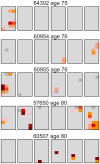Positive selection for new disease mutations in the human germline: evidence from the heritable cancer syndrome multiple endocrine neoplasia type 2B
- PMID: 22359510
- PMCID: PMC3280958
- DOI: 10.1371/journal.pgen.1002420
Positive selection for new disease mutations in the human germline: evidence from the heritable cancer syndrome multiple endocrine neoplasia type 2B
Abstract
Multiple endocrine neoplasia type 2B (MEN2B) is a highly aggressive thyroid cancer syndrome. Since almost all sporadic cases are caused by the same nucleotide substitution in the RET proto-oncogene, the calculated disease incidence is 100-200 times greater than would be expected based on the genome average mutation frequency. In order to determine whether this increased incidence is due to an elevated mutation rate at this position (true mutation hot spot) or a selective advantage conferred on mutated spermatogonial stem cells, we studied the spatial distribution of the mutation in 14 human testes. In donors aged 36-68, mutations were clustered with small regions of each testis having mutation frequencies several orders of magnitude greater than the rest of the testis. In donors aged 19-23 mutations were almost non-existent, demonstrating that clusters in middle-aged donors grew during adulthood. Computational analysis showed that germline selection is the only plausible explanation. Testes of men aged 75-80 were heterogeneous with some like middle-aged and others like younger testes. Incorporating data on age-dependent death of spermatogonial stem cells explains the results from all age groups. Germline selection also explains MEN2B's male mutation bias and paternal age effect. Our discovery focuses attention on MEN2B as a model for understanding the genetic and biochemical basis of germline selection. Since RET function in mouse spermatogonial stem cells has been extensively studied, we are able to suggest that the MEN2B mutation provides a selective advantage by altering the PI3K/AKT and SFK signaling pathways. Mutations that are preferred in the germline but reduce the fitness of offspring increase the population's mutational load. Our approach is useful for studying other disease mutations with similar characteristics and could uncover additional germline selection pathways or identify true mutation hot spots.
Conflict of interest statement
The authors have declared that no competing interests exist.
Figures


Comment in
-
Human disease: Germline selection for deleterious mutation in males.Nat Rev Genet. 2012 Mar 6;13(4):221. doi: 10.1038/nrg3200. Nat Rev Genet. 2012. PMID: 22392218 No abstract available.
Similar articles
-
Novel tandem germline RET proto-oncogene mutations in a patient with multiple endocrine neoplasia type 2B: report of a case and a literature review of tandem RET mutations with in silico analysis.Head Neck. 2013 Dec;35(12):E363-8. doi: 10.1002/hed.23241. Epub 2013 Mar 6. Head Neck. 2013. PMID: 23468374 Review.
-
Multiple Endocrine Neoplasia Type 2B Associated Mixed Medullary and Follicular Thyroid Carcinoma in A Chinese Patient with RET M918T Germline Mutation.Endocr Metab Immune Disord Drug Targets. 2021;21(3):554-560. doi: 10.2174/1871530320666200713092633. Endocr Metab Immune Disord Drug Targets. 2021. PMID: 32660411
-
RET proto-oncogene mutations are restricted to codons 634 and 918 in mainland Chinese families with MEN2A and MEN2B.Clin Endocrinol (Oxf). 2007 Oct;67(4):570-6. doi: 10.1111/j.1365-2265.2007.02927.x. Epub 2007 Jun 15. Clin Endocrinol (Oxf). 2007. PMID: 17573899
-
Double germline mutations in the RET Proto-oncogene in MEN 2A and MEN 2B kindreds.Exp Clin Endocrinol Diabetes. 2006 Apr;114(4):192-6. doi: 10.1055/s-2006-924071. Exp Clin Endocrinol Diabetes. 2006. PMID: 16705552
-
Multiple endocrine neoplasias type 2B and RET proto-oncogene.Ital J Pediatr. 2012 Mar 19;38:9. doi: 10.1186/1824-7288-38-9. Ital J Pediatr. 2012. PMID: 22429913 Free PMC article. Review.
Cited by
-
New insights into the generation and role of de novo mutations in health and disease.Genome Biol. 2016 Nov 28;17(1):241. doi: 10.1186/s13059-016-1110-1. Genome Biol. 2016. PMID: 27894357 Free PMC article. Review.
-
The impact of paternal age on new mutations and disease in the next generation.Fertil Steril. 2022 Dec;118(6):1001-1012. doi: 10.1016/j.fertnstert.2022.10.017. Epub 2022 Nov 6. Fertil Steril. 2022. PMID: 36351856 Free PMC article. Review.
-
Genetic mosaics and the germ line lineage.Genes (Basel). 2015 Apr 17;6(2):216-37. doi: 10.3390/genes6020216. Genes (Basel). 2015. PMID: 25898403 Free PMC article. Review.
-
Germline selection of PTPN11 (HGNC:9644) variants make a major contribution to both Noonan syndrome's high birth rate and the transmission of sporadic cancer variants resulting in fetal abnormality.Hum Mutat. 2022 Dec;43(12):2205-2221. doi: 10.1002/humu.24493. Epub 2022 Nov 24. Hum Mutat. 2022. PMID: 36349709 Free PMC article.
-
Thyroid C-Cell Biology and Oncogenic Transformation.Recent Results Cancer Res. 2015;204:1-39. doi: 10.1007/978-3-319-22542-5_1. Recent Results Cancer Res. 2015. PMID: 26494382 Free PMC article. Review.
References
-
- Raue F, Frank-Raue K. Update multiple endocrine neoplasia type 2. Familial Cancer. 2010;9:449–457. - PubMed
-
- Moline J, Eng C. Multiple Endocrine Neoplasia Type 2. 2010. GeneReviews at GeneTests: Medical Genetics Information Resource (database online) 5/24/2010 ed: Copyright, University of Washington, Seattle. 1997–2010. - PubMed
-
- Kloos RT, Eng C, Evans DB, Francis GL, Gagel RF, et al. Medullary thyroid cancer: management guidelines of the American Thyroid Association. Thyroid. 2009;19:565–612. - PubMed
-
- Kitamura Y, Scavarda N, Wells SA, Jr, Jackson CE, Goodfellow PJ. Two maternally derived missense mutations in the tyrosine kinase domain of the RET protooncogene in a patient with de novo MEN 2B. Hum Mol Genet. 1995;4:1987–1988. - PubMed
Publication types
MeSH terms
Substances
Grants and funding
LinkOut - more resources
Full Text Sources
Other Literature Sources
Medical

